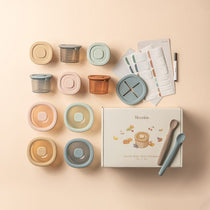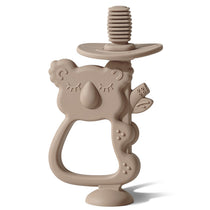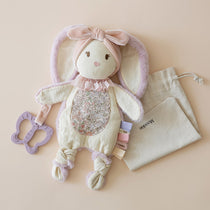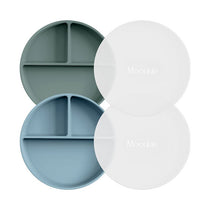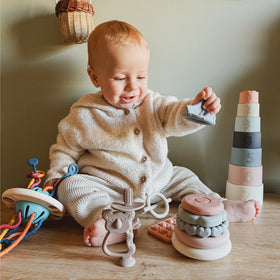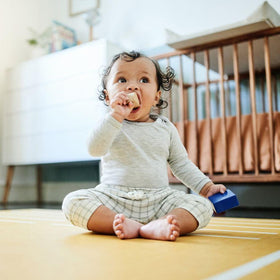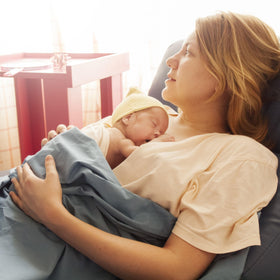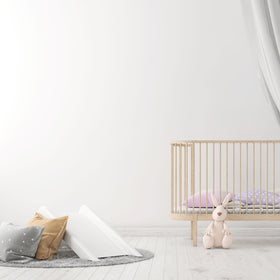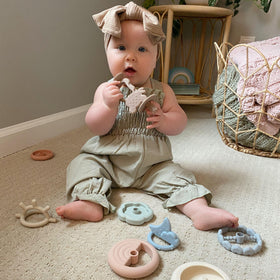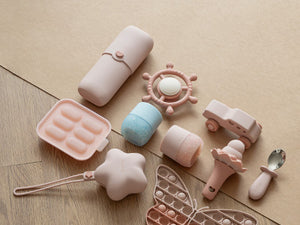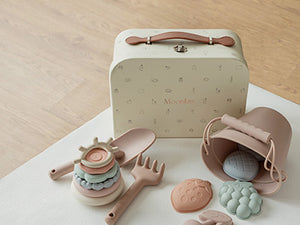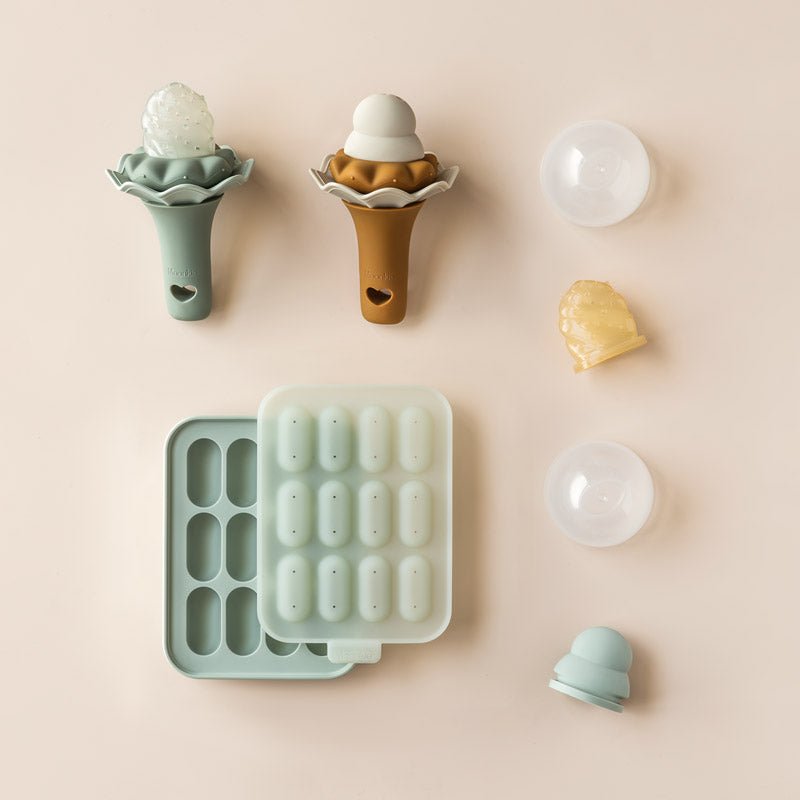Sippy cups have been around long enough that most parents consider them a necessary step between bottles and straw cups. But is this true?
Sippy cups are not necessary for a child's drinking and swallowing skill development. In fact, there is growing evidence that they should not be a step at all because prolonged sippy cup use can impede speech development and proper tongue use.
This idea has been discussed for a while now, so let's get into the nitty gritty to understand the debate, which cups (if any) are better, and how to time transitions.
What Is the Problem with Sippy Cups?
Sippy cups promote tongue, teeth, and mouth positions that are not helpful for drinking, swallowing, and speech development. If used for too long (several months rather than just a couple of months), sippy cup habits can have long-term effects on a child's speech development (source).
However, you won't hear much about the woes of sippy cups until you hear from a speech-language pathologist. The following is a rundown of what they say.
Sippy Cups Change Swallow Patterns
Take a moment to drink water out of an open cup, a straw, and a bottle. Pay attention to your lip, tooth, jaw, and tongue position for each drinking method. These are considered mature swallow patterns because you have to lift your tongue nearly to the ridge behind your front teeth to drink.
Babies do not drink from the breast or bottle this way. They use an immature "shallow" drinking method in which the tongue is pushed low and forward over the lower gums to latch properly and bring milk to the throat (source).
The problem with a hard-spouted sippy cup is that the spout blocks the tongue from rising to the position it should be in for mature swallowing. With the hard spout pushing the tongue down, the toddler doesn't learn to shift his or her tongue to the position it should be in to handle drinking out of an open cup or straw more proficiently (source).
Not all sippy cups are designed with a hard plastic spout. Are they any better? Not really. Even silicone or soft plastic spouts still block the position the tip of the tongue should be in to transition to mature swallowing.
Sippy Cups Bring the Tongue Forward
Since sippy cups force the tongue to stay low and flat, prolonged sippy cup use can impede a toddler's ability to drink well from open cups and straws. Moreover, the toddler may habitually leave the tongue low and flat when speaking (source).

To understand how crucial it is to move your tongue when speaking, try saying the following sentences without lifting your tongue:
Thomas is mowing the lawn.
Zebras are my favorite animal.
Leaping lions are chasing mischievous monkeys.
These are not easy to say with your tongue in a low, forward position, are they? Believe it or not, tongue movement habits are initially built by the way we drink and refined by babbling various sounds in the first year and a half of life.
Sippy Cups May Encourage Mouth Breathing
One concern sippy cups and pacifiers inspire is mouth breathing. Toddlers who have used them for months can develop "paci-mouth," a forward lower jaw position that makes resting with an open mouth comfortable (source).
That low-tongue position from lots of sucking and immature swallowing can be a tough habit to break for toddlers and young children. So, get ahead by weaning from the pacifier before your child's first birthday and skip the sippy cup altogether!
Sippy Cups May Impact Tooth Development
Another issue speech-language pathologists will raise regarding sippy cups and pacifiers is their impact on tooth development. With a low-lying tongue position and a tendency to rest with the mouth open, toddlers may develop an open bite (source).
An open bite occurs when there is a gap between the upper and lower teeth when the mouth is closed. Obviously, this problem is more likely to happen in toddlers who continue using the pacifier constantly or carry the sippy cup around in their mouth as a comfort item.
Why Are Sippy Cups Popular?
So, if sippy cups are not that great for toddlers, why are they so popular? It doesn't take long for a first-time parent to become frustrated at how many spills they have to clean up from obnoxious toddlers entertaining themselves with liquid. The sippy cup was designed to address this problem.
In the 1980s, Richard Belanger found himself in the throes of spill cleanups multiple times a day. The "spill-proof" cups at the time didn't live up to their guarantee, so Belanger, being an engineer by trade, set out to solve the problem.
By the 1990s, Belanger and his wife had landed a deal with Playtex to sell their sippy cups to other frustrated parents (source). It didn't take long before various forms of sippy cups saturated the market so much that modern parents now consider them a necessary step in developing drinking skills.
However, the problem with sippy cups is that they were not invented to help toddlers develop a skill; they were made for parental convenience. No studies or research were consulted to ensure that the sippy cup was safe and helpful to child development; it was simply created to solve a spill issue.
When Should I Transition My Toddler to Open Cups?
Since sippy cups are not ideal for toddler growth and development, when should parents transition their toddlers to open cups? Is there a step in between? Though it seems like a large leap to go from bottle to open cup, it is possible.

You can introduce your little one to an open cup as early as six months old, provided that he or she is able to sit up independently. You should definitely introduce your baby to an open cup before his or her first birthday.
Spills, tantrums, intentional dumps, and coughing will happen. Just ensure you are present as your little one tries to master this skill!
Are Straw Cups Better Than Sippy Cups?
Straw cups are better than sippy cups because they allow the tongue to rise up for mature swallowing. However, the straw must be small enough in diameter to not force the tongue down.
Silicone straws are ideal because they do not poke through the back of the throat in case a toddler falls while drinking. The soft texture of silicone is also excellent because they don't force the tongue down at all.
If you want a truly spill-proof straw cup for your baby or toddler, we have a fantastic option here at Moonkie! Our Silicone Training Cup with Straw comes with two straw options: one valved straw for young learners and one regular flow straw for those who already have the concept down.
Made entirely of silicone, the cup is flexible enough to avoid harming littles who fall on it but sturdy enough to withstand boiling, tantrums, and chucks across the room. It's a nifty addition to your little one's dinner set!
Are Spoutless Sippy Cups Better than Sippy Cups?
Yes and no. As brilliant as the spoutless sippy cup design is (also called the 360 cup), it requires little ones to bite before drinking, which is not proper for overall drinking skills (source). 
Biting while drinking forces a rigidity and forward lower jaw position that open and straw cups don't require; though, the 360 cup does allow the tongue to rise to the alveolar ridge as it should.
My first child had a spoutless 360 cup instead of a sippy cup. I found it useful as a travel cup and for learning to balance the liquid in the cup (i.e., not putting the bottom straight up in the air to take a sip).
However, the cup would leak a bit when dropped on a hard floor, and my son eventually bit through the thin silicone topper. When I switched to an open cup, it took a few weeks for my son to realize that he didn't need to bite the cup to drink.
On the other hand, my second skipped the sippy cup and spoutless sippy cup altogether. She went from breast to straw cup to open cup by her first birthday. The transition to an open cup was undoubtedly more straightforward with her because she already knew that she didn't have to tip the cup all the way to get a drink.
Moreover, she didn't harm her teeth or gums while trying to bite a hard open cup and struggled less with swallowing. I've noticed similar trends among nephews, nieces, and toddlers at the nursery I volunteer in, though I am not with them all day every day.
Long story short, skip sippy cups and spoutless 360 cups in your baby's drink training. It's best to go from breast or bottle to straw cup to open cup.
Should I Rotate Various Cup Types for My Toddler?
Rotating between straws, sippy cups, 360 cups, and open cups is a better option than going solely with a sippy cup, but it's not as ideal or practical as sticking with one or two types of cups at a time.
The main reason parents buy sippy cups is to have an easy-to-grasp cup that doesn't spill when you're out and about. I get it. But some amazingly spill-proof straw cups on the market nowadays make avoiding sippy and 360 cups easy.
When it comes down to it, the skills and mouth form your toddler must use with a sippy or 360 cup will never be used for other drinking cup types. As an adult, I haven't used anything like a sippy or spoutless cup that required a bite to drink. So why teach those skills to your child at all?
What Are Other Ways to Promote Speech Development?
Choosing cups that don't hinder your little one's tongue, jaw, and mouth position is crucial to helping your child move his or her mouth freely. But what can we do to actively promote our little ones' speech development? We can play with them!

Play is essential to physical, mental, and emotional development. It helps little ones learn to coordinate their fine and gross motor movements, practice problem-solving skills, communicate with others, act out scenarios, and coordinate with others.
Play also sparks creativity, helps process the world, and improves emotion management. Can you believe that all of this starts when regularly making eye contact with your infant?
To learn more about how play can help your toddler's speech development, read The Power of Play in Speech Development: Best Activities for Toddlers.
Speak, Listen, Converse
Another way you can help promote speech development in your baby or toddler is by having conversations with one another. Speaking often with and actively listening to your little one encourages language development.
Here are some ways to do this well:
Make eye contact
Speak face-to-face
Use your hands, facial expressions, and tone of voice as you speak
Ask questions
Talk about what you are doing as you do it
Describe the things around you as you walk or sit somewhere
Introduce people and pets to your little one
Encourage responses (even babbling from babies)
Restate what your toddler says to confirm what you heard
Will Teaching My Toddler Another Language Confuse Speech Development?
No, teaching your toddler another language will not confuse speech development. It is common for babies and toddlers around the world to learn more than one language, and they are particularly adept at picking them up!

The earlier you begin, the better. Babies are most open to hearing nuanced pronunciation in their first year. Once they latch onto certain patterns, they are a little less flexible in picking up on tiny pronunciation differences, but they can still pick them up faster than an adult.
However, if you notice that your child cannot form a particular sound in either language, you should talk to a speech-language pathologist to see whether your child can form the sound at all with help (source).
For more on teaching your young child another language, read Supporting Bilingual Toddlers: Tips for Raising a Multilingual Child.
In a Nutshell
Does using a sippy cup mean your little one will not develop proper swallowing habits and clear speech? Not necessarily. Some children rotate through enough different types of cups that having a sippy cup in the mix for a time doesn't seem to hamper their abilities.
However, skipping the sippy cup entirely is possible these days thanks to better spill-proof options that actually take child development into consideration.


